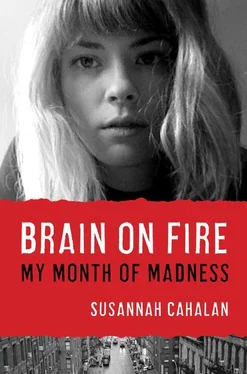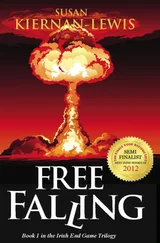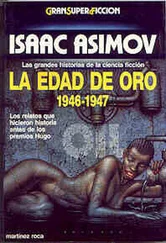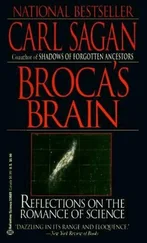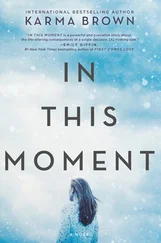15 “postictal fury”: S. J. Logsdail and B. K. Toone, “Post-Ictal Psychoses: A Clinical and Phenomenological Description,” British Journal of Psychiatry 152 (1988): 246–252.
16 A quarter of psychotic people: Michael Trimble, Andy Kanner, and Bettina Schmitz, “Postictal Psychosis,” Epilepsy and Behavior 19 (2010): 159–161.
CHAPTER 17: MULTIPLE PERSONALITY DISORDER
17 I was within the age range for psychotic breaks: The New York Times Health Guide, “Schizophrenia,” Health.nytimes.com, http://health.nytimes.com/health/guides/disease/schizophrenia/risk-factors.html(accessed February 20, 2010).
18 dissociative identity disorder (DID): “Dissociative Identity Disorder,” in American Psychiatric Association, Diagnostic and Statistical Manual of Mental Disorders—IV (Text Revision) (Washington, D.C.: American Psychiatric Association, 2 000), 526–529.
19 On of a scale from 1 (most dire cases) to 100: “Bipolar Disorder,” in ibid.
CHAPTER 18: BREAKING NEWS
20 “Like a bolt from the blue”: P. A. Pichot, “A Comparison of Different National Concepts of Schizoaffective Psychosis,” in Schizoaffective Psychoses (Berlin: Springer-Verlag, 1986), 8–16. A. Marneros and M. T. Tsuang, “Schizoaffective Questions and Directions,” in Schizoaffective Psychoses (Berlin: Springer-Verlag, 1986).
21 “uninterrupted period of illness during”: American Psychiatric Association, Diagnostic and Statistical Manual of Mental Disorders—IV (Text Revision) (Washington, D.C.: American Psychiatric Association, 2000), 319–323.
CHAPTER 21: DEATH WITH INTERRUPTIONS
22 In 1933, a bicycle struck seven-year-old Henry Gustav Molaison: Luke Dittrich, “The Brain That Changed Everything,” Esquire.com, October 5, 2010, www.esquire.com/features/henry-molaison-brain-1110(accessed May 8, 2011). “Histopathological Examination of the Brain of Amnesiac Patient H.M.,” Brain Observatory, August 18, 2010, http://thebrainobservatory.ucsd.edu/content/histopathological-examination-brain-amnesic-patient-hm(accessed May 8, 2011). William Beecher Scoville and Brenda Milner, “Loss of Recent Memory after Bilateral Hippocampal Lesions,” Journal of Neurology, Neurosurgery and Psychiatry 20 (1957): 11–21. Benedict Carey, “H.M., an Unforgettable Amnesiac, Dies at 82,” New York Times, December 5, 2008, http://www.nytimes.com/2008/12/05/us/05hm.html?pagewanted=all(accessed May 8, 2011).
23 “Clive was under the constant impression”: Deborah Wearing, Forever Today: A True Story of Lost Memory and Never-Ending Love (London: Corgi, 2006).
24 “I haven’t heard anything”: Oliver Sacks, “The Abyss: Music and Amnesia,” New Yorker, September 24, 2007, http://www.newyorker.com/reporting/2007/09/24/070924fa_fact_sacks(accessed September 13, 2011).
CHAPTER 22: A BEAUTIFUL MESS
25 At the top of the spinal cord and at the underside of the brain: Michael O’Shea, The Brain: A Very Short Introduction (Oxford: Oxford University Press, 2005). Rita Carter, Susan Aldridge, Martyn Page, and Steve Parker, The Human Brain Book (London: DK Adult, 2009). Stephen G. Waxman, Clinical Neuroanatomy, Twenty-Sixth Edition (New York: McGraw Hill, 2010).
26 “The brain is a monstrous, beautiful mess”: William F. Allman, Apprentices of Wonder: Inside the Neural Network Revolution (New York: Bantam, 1989), 3.
27 IVIG is made up of serum antibodies: Falk Nimmerjahn and Jeffrey V. Ravetch, “The Anti-Inflammatory Activity of IgG: The Intravenous IgG Paradox,” Journal of Experimental Medicine 204 (2007): 11–15. Arturo Casadevall, Ekaterina Dadachova, and Liise-Anne Pirofski, “Passive Antibody Therapy for Infectious Diseases,” Nature Reviews Microbiology 2 (2004): 695–703. Noah S. Scheinfeld, “Intravenous Immunoglobulin,” Medscape Reference, http://emedicine.medscape.com/article/210367-overview(accessed May 8, 2011).
28 Antibodies are created by the body’s immune system: John M. Dwyer, The Body at War: The Story of Our Immune System (Sydney, Australia: Allen & Unwin, 1994), 28–52. S. Jane Flint, Lynn W. Enquist, Vincent R. Racaniello, and A. M. Skalka, Principles of Virology: Molecular Biology, Pathogenesis, and Control of Animal Viruses, Third Edition (Washington, D.C.: American Society of Microbiology, 2009), 86–130. Noel R. Rose and Ian R. Mackay, eds., The Autoimmune Diseases, Fourth Edition (St. Louis, Mo.: Elsevier, 2006). Lauren Sompayrac, How the Immune System Works, Third Edition (Oxford: Blackwell, 2008). Massoud Mahmoudi, Immunology Made Ridiculously Simple (Miami: Med Master, 2009). Robert G. Lahita, Women and Autoimmune Disease: The Mysterious Ways Your Body Betrays Itself (New York: Morrow, 2004).
29 ten days versus the innate system’s minutes or hours: Vincent Racaniello, “Innate Immune Defenses,” Virology.ws, http://www.virology.ws/2009/06/03/innate-immune-defenses(accessed March 11, 2010). Vincent Racaniello, “Adaptive Immune Defenses,” Virology.ws, http://www.virology.ws/2009/07/03/adaptive-immune-defenses(accessed March 11, 2010).
30 collateral damage of these internal battles: Lauren Sompayrac, How the Immune System Works, Third Edition (Oxford: Blackwell, 2008). Massoud Mahmoudi, Immunology Made Ridiculously Simple (Miami: Med Master, 2009). Robert G. Lahita, Women and Autoimmune Disease: The Mysterious Ways Your Body Betrays Itself (New York: Morrow, 2004).
31 plasma cells that create antibodies: John M. Dwyer, The Body at War: The Story of Our Immune System (Sydney, Australia: Allen & Unwin, 1994), 28–52. S. Jane Flint, Lynn W. Enquist, Vincent R. Racaniello, and A. M. Skalka, Principles of Virology: Molecular Biology, Pathogenesis, and Control of Animal Viruses, Third Edition (Washington, D.C.: American Society of Microbiology, 2009), 86–130. Noel R. Rose and Ian R. Mackay, eds., The Autoimmune Diseases: Fourth Edition (St. Louis: Elsevier, 2006). Lauren Sompayrac, How the Immune System Works, Third Edition (Oxford: Blackwell, 2008). Massoud Mahmoudi, Immunology Made Ridiculously Simple (Miami: Med Master, 2009). Robert G. Lahita, Women and Autoimmune Disease: The Mysterious Ways Your Body Betrays Itself (New York: Morrow, 2004).
32 WIRED ’N MIRED: Brendan T. Carroll, Christopher Thomas, Kameshwari Jayanti, John M. Hawkins, and Carrie Burbage, “Treating Persistent Catatonia When Benzodiazepines Fail,” Current Psychiatry 4 (2005): 59.
33 Although developed in the mid-1950s: Janus Kremer, “Clock Drawing in Dementia: A Critical Review,” Revista Neurologica Argentina 27 (2002): 223–227.
34 The healthy brain enables vision: Francesco Pavani, Elisabetta Ladavas, and Jon Driver, “Auditory and Multisensory Aspects of Visuospatial Neglect,” Trends in Cognitive Sciences 7 (2008): 407–414. V. S. Ramachandran and Sandra Blakeslee, Phantoms in the Brain: Probing the Mysteries of the Human Mind (New York: Morrow, 1998), 115–125. V. S. Ramachandran, The Tell-Tale Brain: A Neuroscientist’s Quest for What Makes Us Human (New York: Norton, 2011), 1–21. Michael O’Shea, The Brain: A Very Short Introduction (Oxford: Oxford University Press, 2005). Rita Carter, Susan Aldridge, Martyn Page, and Steve Parker, The Human Brain Book (London: DK Adult, 2009). Stephen G. Waxman, Clinical Neuroanatomy, Twenty-Sixth Edition (New York: McGraw-Hill, 2010).
Читать дальше
